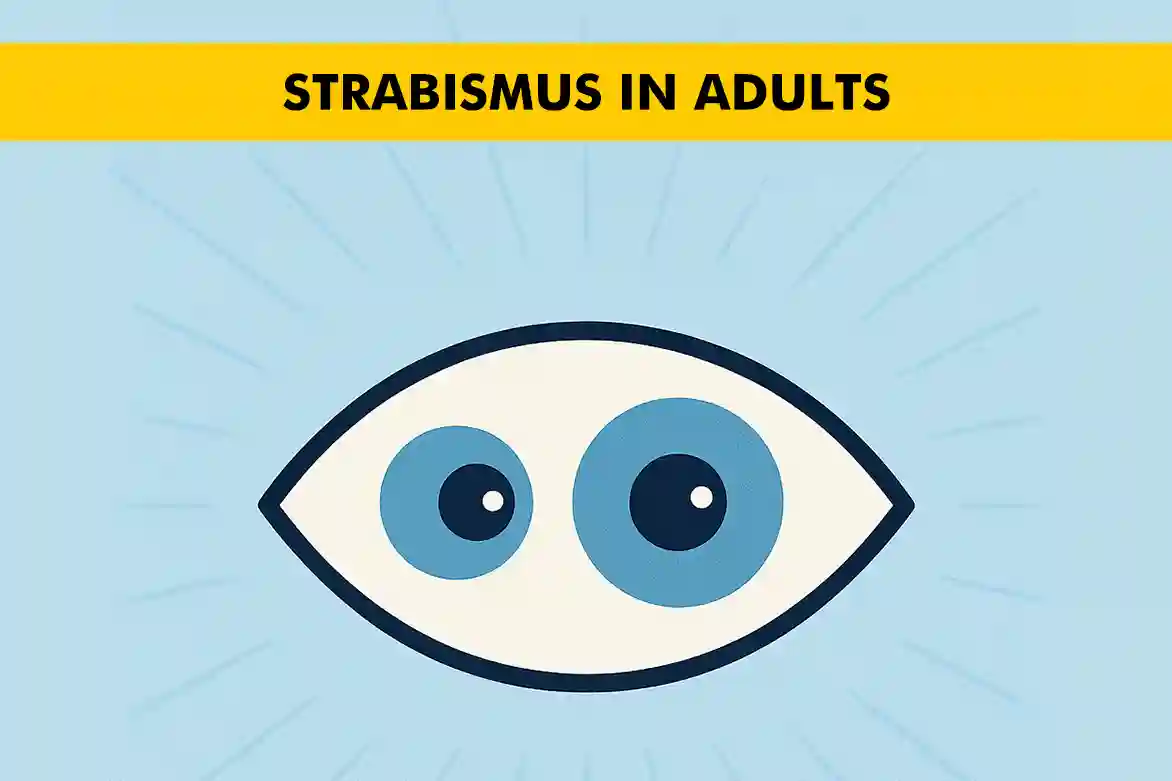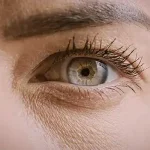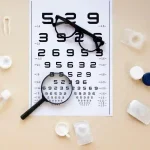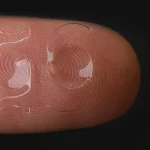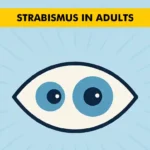Strabismus, or a squint eye, is often perceived as a childhood condition that affects eye alignment. However, it can also develop in adulthood, posing unique challenges and requiring specific treatments. Adult-onset strabismus can lead to double vision and depth perception issues and can significantly impact daily life.
Understanding the causes, symptoms, and treatment options for adult strabismus can help individuals manage this condition more effectively and lead a better quality of life. This article delves into the intricacies of adult-onset strabismus, from diagnosis to treatment and beyond.
Understanding Adult-Onset Strabismus
Adult-onset strabismus refers to the misalignment of the eyes that occurs after childhood. Unlike pediatric strabismus, which is often congenital or develops early in life, adult strabismus can be triggered by various factors, including trauma, neurological disorders, and systemic illnesses. It is important to note that the onset of this condition can be gradual or sudden, depending on the underlying cause. This can sometimes make it challenging to diagnose promptly, as symptoms may initially be subtle or mistaken for other vision issues.
This condition can manifest in different ways, including esotropia (inward turning of the eye), exotropia (outward turning of the eye), and hypertropia (upward turning of the eye). Understanding the type and cause of strabismus is crucial for determining the most effective treatment. Additionally, recognizing the specific pattern of eye movement can help in tailoring a treatment plan that addresses both the physical and functional aspects of the condition, ultimately improving the patient’s quality of life.
Common Causes of Strabismus in Adults
Several factors can lead to the development of strabismus in adults.
- Neurological conditions, such as stroke or nerve damage, can lead to the development of strabismus in adults.
- Thyroid eye disease is another contributing factor that can affect eye alignment.
- Diabetes can impact the nerves and muscles controlling eye movement, resulting in strabismus.
- Trauma to the eye or head can cause misalignment of the eyes.
- Age-related changes in the eye muscles or nerves may also contribute to the onset of strabismus.
Understanding these causes can aid in early diagnosis and timely intervention, which are crucial for effective management.
Symptoms and Diagnosis: What to Look For
Symptoms of Strabismus
- Misalignment of one or both eyes is the main symptom of strabismus.
- Look for double vision, which often accompanies this condition.
- Difficulty focusing on objects can be another indicator.
- Eye strain is a common complaint among those affected.
- Headaches may occur in some individuals.
- Impaired depth perception is also a possible symptom.
Diagnosis of Strabismus
- Diagnosing strabismus in adults generally requires a comprehensive eye exam.
- The exam may include tests for visual acuity to assess clarity of vision.
- Eye alignment tests are conducted to check how well the eyes work together.
- Eye muscle function tests help determine the strength and coordination of eye muscles.
- Early diagnosis is crucial to prevent complications.
- Starting appropriate treatment promptly is essential for effective management.
Risk Factors and Health Concerns
Certain risk factors can significantly increase the likelihood of developing strabismus in adulthood.
- A family history of eye disorders can predispose individuals to strabismus due to genetic factors affecting eye alignment.
- Underlying health conditions, such as diabetes or thyroid disease, can contribute to strabismus by impacting the nerves and muscles responsible for eye movement.
- Previous eye surgery or trauma can alter the structure or function of the eyes, increasing the risk of misalignment.
- Understanding these risk factors is crucial for early detection and intervention.
- These factors can guide patients and healthcare providers in monitoring and managing potential eye health issues.
Untreated strabismus can lead to several health concerns:
- Persistent double vision, which can affect daily activities.
- Reduced vision in the affected eye, known as amblyopia.
- Difficulties with coordination and balance, impacting mobility.
- Regular eye check-ups to monitor eye health.
Treatment Options for Adult Strabismus
Treatment varies based on cause and severity.
- Glasses or contact lenses can correct vision.
- Prism lenses help align vision.
- Vision therapy improves eye coordination.
- Eye muscle exercises strengthen eye muscles.
Surgical and Non-Surgical Treatments
- Surgical intervention may be required to correct the alignment of eye muscles in certain cases.
- Botox injections can temporarily paralyze overactive eye muscles, aiding in alignment improvement.
- It is crucial to consult an eye care professional to determine the most appropriate treatment plan.
Managing and Preventing Strabismus Progression
Effective Management of Strabismus
- Tailored Treatment Plans: Management of strabismus requires a personalized approach, with treatments specifically designed to address the individual’s unique condition.
- Regular Monitoring: Consistent follow-ups with an eye care specialist are crucial to keep track of the condition’s progress.
- Treatment Adjustments: Based on regular assessments, treatments may need to be adjusted to ensure optimal effectiveness.
- Collaborative Care: Working closely with healthcare providers helps in making informed decisions about the best management strategies.
Strategies for Preventing Strabismus Progression
- Maintain Overall Health: Prioritize a healthy lifestyle to support eye health and prevent strabismus from worsening.
- Manage Chronic Conditions: Keep chronic illnesses like diabetes and thyroid disorders under control to reduce their impact on eye alignment.
- Protect Eyes from Injury: Use protective eyewear during activities that pose a risk to eye safety to prevent trauma-induced strabismus.
- Early Intervention: Seek prompt medical attention at the first sign of strabismus to address the condition before it progresses.
- Consistent Management: Regularly follow up with healthcare providers to monitor and adjust treatment plans as needed, ensuring optimal outcomes.
Living with Strabismus: Tips and Support
- Living with strabismus presents challenges, but various strategies can aid in managing the condition effectively.
- Utilize corrective lenses to enhance vision and improve daily functioning.
- Engage in regular eye exercises to strengthen eye muscles and coordination.
- Seek support from vision therapists for personalized guidance and treatment plans.
- Join support groups to connect with others who understand the challenges of strabismus.
- Consider counseling for emotional support and practical advice.
- Stay informed about treatment options to make empowered decisions.
- Proactively manage the condition to lead a fulfilling life despite its challenges.
Conclusion
Strabismus in adults presents unique challenges but is manageable with the right approach. Understanding the causes, recognizing the symptoms, and seeking timely treatment are crucial steps in managing this condition effectively.
By staying informed and proactive, individuals with adult-onset strabismus can navigate their condition successfully and maintain a good quality of life. Regular eye check-ups and consultations with eye care professionals are essential for ongoing management and support.
FAQs
Yes, strabismus can develop suddenly in adulthood, often due to acute medical conditions such as stroke, trauma, or neurological disorders. Sudden onset of strabismus should be evaluated by a healthcare provider immediately.
Double vision is a common symptom of strabismus, but it can also be caused by other eye conditions. Therefore, a thorough eye examination is necessary to determine the underlying cause.
Acquired strabismus can sometimes be treated without surgery, using methods like prism glasses, vision therapy, or Botox injections. However, the effectiveness of these treatments varies, and surgery may be required in some cases.
A stroke can affect eye alignment by damaging the nerves that control eye movement, leading to strabismus. Rehabilitation and specific treatments are essential for managing these effects.
You should see a doctor for any sudden eye misalignment or double vision, especially if accompanied by other symptoms like headaches or difficulty speaking, as these could indicate a serious underlying condition.
